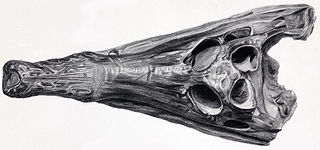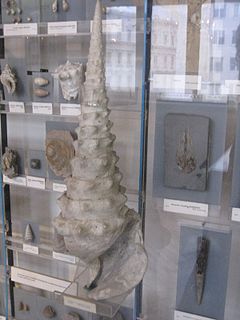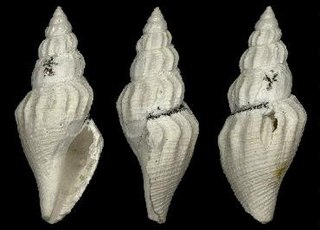Related Research Articles

Eucyclidae is a family of gastropods in the superfamily Seguenzioidea.

Abyssochrysidae is a family of sea snails, marine gastropod mollusks in the clade Caenogastropoda.

Kentisuchus is an extinct genus of tomistomine crocodylian. It is considered one of the most basal members of the subfamily. Fossils have been found from England and France that date back to the early Eocene. The genus has also been recorded from Ukraine, but it unclear whether specimens from Ukraine are referable to Kentisuchus.

Campanile is a genus of large sea snails, marine gastropod molluscs in the family Campanilidae.

Branchioplax is an extinct genus of crab which existed in Alaska and Washington during the Eocene period. It was first named by Mary Rathbun in 1916, and contains ten species , including Branchioplax washingtoniana from the Hoko River Formation, Branchioplax carmanahensis, and Branchioplax ballingi.
Conorbis is an extinct genus of sea snails, marine gastropod mollusks in the family Conorbidae.
Plesiothyreus is a genus of very small sea snails or limpets, marine gastropod mollusks in the family Phenacolepadidae.

The Hoko River Formation is a Late Eocene marine sedimentary geologic formation. The formation is exposed in outcrops along the Strait of Juan de Fuca on the Olympic Peninsula in Washington state, USA. It is known for containing numerous fossils of crabs. It overlies the older Lyre Formation and underlies the younger Makah Formation.

Paleontology in South Carolina refers to paleontological research occurring within or conducted by people from the U.S. state of South Carolina. Evidence suggests that at least part of South Carolina was covered by a warm, shallow sea and inhabited by trilobites during the Cambrian period. Other than this, little is known about the earliest prehistory of South Carolina because the Ordovician, Silurian, Devonian, Carboniferous, Permian, Triassic, and Jurassic, are missing from the state's local rock record. The earliest fossils of South Carolina date back to the Cretaceous, when the state was partially covered by seawater. Contemporary fossils include marine invertebrates and the remains of dinosaur carcasses that washed out to sea. On land, a wide variety of trees grew. Sea levels rose and fell throughout the ensuing Cenozoic era. Local marine life included invertebrates, fish, sharks, whales. The first scientifically accurate identification of vertebrate fossils in North America occurred in South Carolina. In 1725, African slaves digging in a swamp uncovered mammoth teeth, which they recognized as originating from an elephant-like animal.

Paleontology in Florida refers to paleontological research occurring within or conducted by people from the U.S. state of Florida. Florida has a very rich fossil record spanning from the Eocene to recent times. Florida fossils are often very well preserved.

Paleontology in Texas refers to paleontological research occurring within or conducted by people from the U.S. state of Texas. Author Marian Murray has remarked that "Texas is as big for fossils as it is for everything else." Some of the most important fossil finds in United States history have come from Texas. Fossils can be found throughout most of the state. The fossil record of Texas spans almost the entire geologic column from Precambrian to Pleistocene. Shark teeth are probably the state's most common fossil. During the early Paleozoic era Texas was covered by a sea that would later be home to creatures like brachiopods, cephalopods, graptolites, and trilobites. Little is known about the state's Devonian and early Carboniferous life. However, evidence indicates that during the late Carboniferous the state was home to marine life, land plants and early reptiles. During the Permian, the seas largely shrank away, but nevertheless coral reefs formed in the state. The rest of Texas was a coastal plain inhabited by early relatives of mammals like Dimetrodon and Edaphosaurus. During the Triassic, a great river system formed in the state that was inhabited by crocodile-like phytosaurs. Little is known about Jurassic Texas, but there are fossil aquatic invertebrates of this age like ammonites in the state. During the Early Cretaceous local large sauropods and theropods left a great abundance of footprints. Later in the Cretaceous, the state was covered by the Western Interior Seaway and home to creatures like mosasaurs, plesiosaurs, and few icthyosaurs. Early Cenozoic Texas still contained areas covered in seawater where invertebrates and sharks lived. On land the state would come to be home to creatures like glyptodonts, mammoths, mastodons, saber-toothed cats, giant ground sloths, titanotheres, uintatheres, and dire wolves. Archaeological evidence suggests that local Native Americans knew about local fossils. Formally trained scientists were already investigating the state's fossils by the late 1800s. In 1938, a major dinosaur footprint find occurred near Glen Rose. Pleurocoelus was the Texas state dinosaur from 1997 to 2009, when it was replaced by Paluxysaurus jonesi after the Texan fossils once referred to the former species were reclassified to a new genus.

The Hatchetigbee Bluff Formation is a geologic formation in Alabama, Georgia, Louisiana and Mississippi. The youngest unit of the Wilcox Group preserves fossils dating back to the Ypresian stage of the Eocene period, or Wasatchian in the NALMA classification. The formation is named for Hatchetigbee Bluff on the Tombigbee River, Washington County, Alabama.

The Las Tetas de Cabra Formation is a geologic formation in Mexico. It preserves fossils dating back to the Wasatchian of the Early Eocene period.
Digitolabrum is an extinct genus of sea snails in the family Aporrhaidae. Most species are from the Eocene of France. D. abedi and D. elegans are from the Eocene of Egypt.
The Algoa Group is one of five geological groups which comprise the coastal Cenozoic geological deposits in South Africa. The Algoa Group contains six formations which range from Middle Eocene to Late Holocene in age.
Eoconus sauridens is an extinct species of sea snail, a marine gastropod mollusk, in the family Conidae.
Tectariopsis is an extinct genus of sea snails, marine gastropod mollusks, in the family Turbinidae.

Raphitoma baudoni is an extinct species of sea snail, a marine gastropod mollusc in the family Raphitomidae.

Raphitoma dictyella is an extinct species of sea snail, a marine gastropod mollusc in the family Raphitomidae.

Raphitoma leptocolpa is an extinct species of sea snail, a marine gastropod mollusc in the family Raphitomidae.
References
- ↑ Catalogue illustré de coquilles fossiles de l'Eocène des environs de Paris.(3 fase.) M Cosmann, 1888, Annales de la Société Royale Malacologique de Belgique, 23, pages 3-328
- ↑ H. L. Abbass. 1967. A monograph on the Egyptian Paleocene and Eocene gastropods. United Arab Republic, Geological Survey-Geological Museum, Palaeontological Series, Monograph (4)1-154
- ↑ Late Jurassic and Early Cretaceous gastropodsof the north of Middle Siberia (systematic composition,paleoecology, stratigraphic and paleogeographic significance). Beizel, A.L., Proc. Inst. Geol. Geophys. SB RAS, 1983, no. 484, pages 1–94
- ↑ Calliomphalus Cossmann, 1888 † . Retrieved through: World Register of Marine Species on 17 December 2018.